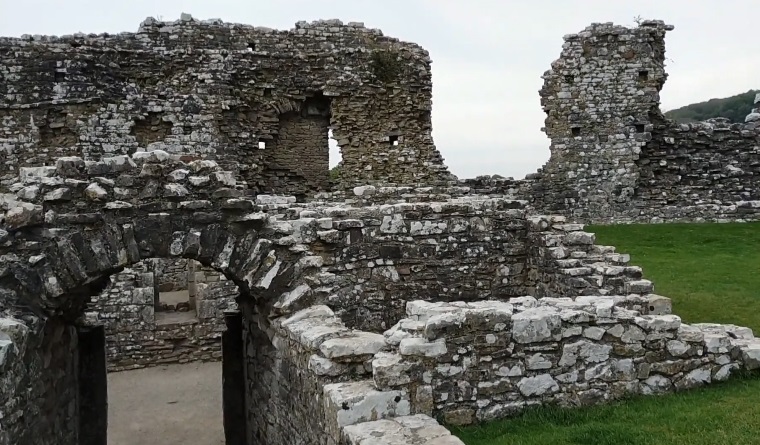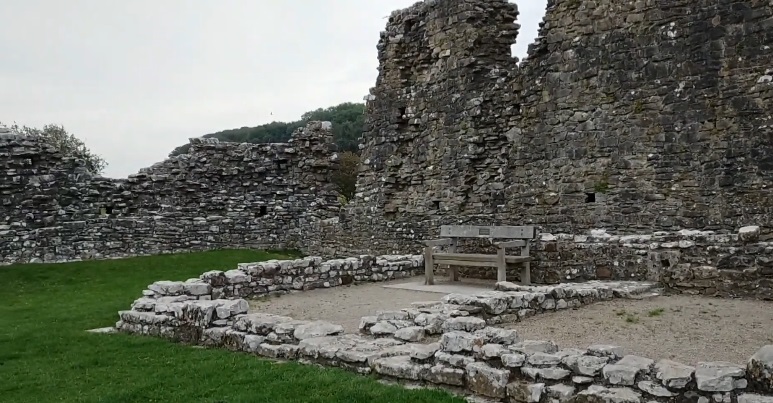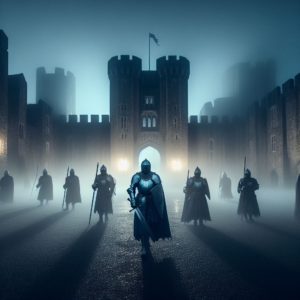INTRODUCTION
Nestled on the banks of the River Ewenny in South Wales, Ogmore Castle history and stories is one of the region’s oldest Norman strongholds, built in the early 12th century by Norman lord William de Londres, Ogmore was a key part of the Norman strategy to control South Wales. Today, the castle’s tranquil, scenic beauty contrasts with eerie stories of restless spirits. In this post, we’ll explore the history of Ogmore Castle, share the ghostly tales that make it one of Wales’s most intriguing, haunted sites, compare it to nearby Coity Castle, delve into how the Norman conquest impacted local Welsh communities, and imagine the daily lives of those who lived within its walls.
A Glimpse into the History of Ogmore Castle
Ogmore Castle was constructed around 1106 as part of the Norman campaign to establish dominance over South Wales. Built by William de Londres, one of Robert Fitzhamon’s twelve knights, the castle’s position along the River Ewenny offered a natural defense, with the river acting as a barrier on one side. As a fortified outpost, Ogmore served as a local hub for enforcing Norman authority and protecting against Welsh resistance.
The de Londres family held Ogmore for generations, strengthening the castle’s defenses over time. Although it began as a simple wooden motte-and-bailey structure, Ogmore Castle was eventually rebuilt in stone, with sections of the keep and curtain walls still standing. The castle slowly fell into disuse as its strategic importance waned, becoming the atmospheric ruin it is today—a place where history and legend intertwine.
Local Perspectives: The Norman Conquest Through Welsh Eyes
To fully appreciate Ogmore Castle, it’s essential to consider the Welsh perspective on the Norman conquest. For the Welsh people, the arrival of Norman lords and the construction of castles like Ogmore and Coity marked a period of intense upheaval, where traditions clashed with the structured, feudal strategies of the Normans.
Resistance and Resilience
The Welsh lords, or tywysogion, fought fiercely to maintain their lands and autonomy. Figures like Rhys ap Gruffudd and later Llywelyn the Great mounted strong resistance against the Norman encroachment. Castles like Ogmore were both symbols of Norman control and focal points of resistance for Welsh forces determined to reclaim their land. For the Welsh, these castles represented a physical reminder of the struggle for sovereignty.
The Cultural and Social Impact of Ogmore Castle history and stories

The Norman conquest not only changed political boundaries but also reshaped daily life. The Normans introduced feudalism, a system that clashed with Welsh customs of kinship (cenedl) and community land rights. Local tenants, who had previously been independent farmers, found themselves subject to Norman lords, disrupting traditional Welsh ways of life, especially around castles like Ogmore.
Over time, however, Welsh identity incorporated elements of Norman heritage, blending traditions in law, art, and language. Today, the castles are symbols of both conquest and resilience, representing the strength of Welsh culture and its ability to adapt to external influences.
Ogmore Castle vs. Coity Castle: Comparing Two Norman Strongholds
MAP LINK TO COITY CASTLE
MAP LINK TO OGMORE CASTLE
Ogmore Castle is often compared to nearby Coity Castle, another Norman fortress built around the same time. Both castles were part of a Norman defensive network, but they served distinct roles.
- Strategic Role and Founding: Ogmore Castle guarded the river and protected against coastal threats. Coity, established by Payn de Turberville, was positioned further inland to defend against Welsh forces to the north. Together, they formed a defensive network that secured Norman control in Glamorgan.
- Architectural Evolution: Ogmore’s design includes a small stone keep and curtain walls, along with unique stone steps leading to the river—some of the oldest examples of their kind in Britain. Coity Castle, however, expanded over the centuries, with additional gatehouses, defensive walls, and multiple layers of fortification.
- Role in Welsh Resistance: While Ogmore Castle saw limited involvement in Welsh uprisings, Coity played a more active role, especially during campaigns led by Llywelyn the Great. The Turberville family, who held Coity, fortified the castle to withstand these attacks, giving it a more robust structure.
Through this comparison, we see how Norman lords adapted their castles to the unique terrain and challenges in South Wales, with each site reflecting its own distinct role in the broader campaign.
Daily Life at Ogmore Castle: Lords, Ladies, Servants, and Soldiers
Ogmore Castle was more than a military stronghold; it was a lively center of daily life, where a complex network of people worked together to sustain the lord’s household. From the de Londres family to the local villagers who supported the castle’s needs, each person played a role in Ogmore’s community.
The Lords and Ladies managed the castle’s administration, entertaining guests and overseeing the local population. Soldiers maintained defenses and kept watch, always prepared to defend against potential threats. Servants and household staff cooked, cleaned, and tended to the daily needs of the noble family, while craftsmen and laborers provided essential services like blacksmithing, carpentry, and groundskeeping. Finally, villagers and tenant farmers worked the surrounding lands, supplying food and resources in exchange for protection.
This unique community, bound by feudal loyalty and necessity, is one of the lesser-known aspects of Ogmore Castle’s history but a crucial part of its story. From the noble family to the tenant farmers, each played a part in the castle’s life and legacy.
Ogmore Castle history and stories Ghosts and legend’s
Beyond its historical significance, Ogmore Castle has a reputation for paranormal activity. Legends of the White Lady and ghostly soldiers add to its mystery, making it one of Wales’s most atmospheric ruins.
The White Lady of Ogmore Castle
The White Lady is the most famous ghostly figure associated with Ogmore Castle. According to local tales, a spectral woman dressed in white appears at twilight. Wandering the ruins as if searching for something. Some believe she was a member of the de Londres family or a local noblewoman who met a tragic end. Visitors describe her as a faint, ghostly figure, gliding silently before vanishing into the night.
The Ghostly Soldiers
In addition to the White Lady, there are reports of ghostly soldiers haunting the grounds. Visitors have heard the faint sounds of clashing swords, distant cries, and footsteps, especially near the riverbank. Some believe these sounds are echoes of old battles, locked in a spectral replay of Ogmore’s turbulent past.
A Haunted Atmosphere
Many visitors have reported sudden chills and cold spots near the stone steps and keep. Others have heard whispers carried on the wind, adding to Ogmore’s haunted reputation. These strange occurrences make Ogmore Castle a must-visit for those intrigued by ghostly legends and Welsh folklore.
Planning Your Visit to Ogmore Castle
If you’re intrigued by Ogmore Castle’s history and haunted legends, visiting offers a chance to explore its story firsthand. Here are some tips:
- Best Time to Visit: For those hoping to catch a glimpse of the White Lady, twilight is ideal. But bring a flashlight if you plan to stay after sunset.
- Nearby Landmarks: Ogmore Castle is close to other historic sites, including Coity Castle and scenic coastal trails.
- Practical Information: The castle ruins are free to explore, with nearby parking. The ground around the castle can be uneven, especially near the river, so sturdy footwear is recommended.
Conclusion
Ogmore Castle is a place where history and mystery meet. Its haunting ruins and ghostly tales offer an engaging glimpse into South Wales’s Norman past. Whether you’re visiting for its historical significance, paranormal intrigue, or scenic beauty, Ogmore Castle invites you to step back in time. And if you’re curious about the region’s Norman legacy, be sure to explore Coity Castle—a fortress that reveals yet another side of the Norman impact on Wales.
Disclaimer:
While the existence of ghosts remains unproven, these legends have captivated imaginations for centuries. Adding to the allure of Ogmore Castle history and stories
Acknowledging Skeptical Viewpoints
While tales of they may seem fantastical to some, others find solace in the rational explanations offered by skeptics. Yet, even in the face of doubt, the allure of Cardiff Castle’s legend remains undiminished, its mysteries beckoning to those with a thirst for adventure and discovery.
SUBSCRIBE AT BRIANWELSH500.COM/CONTACT




